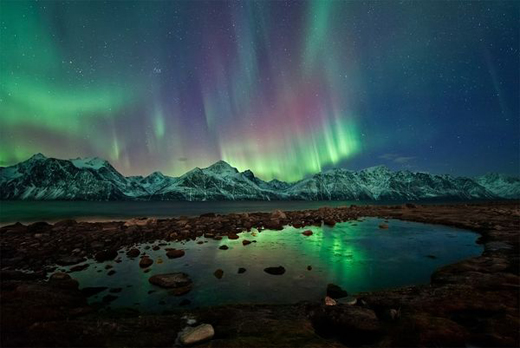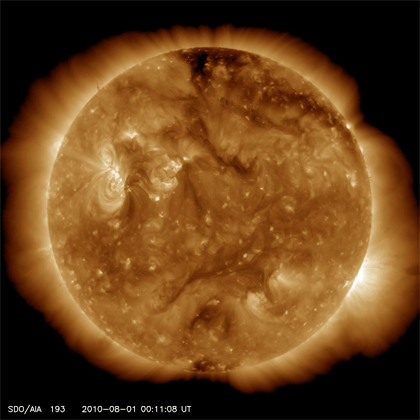Submitted by chandra on Wed, 2012-03-07 18:11
On Friday March 2, 2012, we noticed Sunspot Group 1429 moving onto the Earth facing part of the Sun. The NOAA space weather service informed us that the magnetic topology was complex and this was a cell to watch out for. Sure enough, on Sunday night (March 4, Eastern time) the Sun emitted a short X1 flare. We all felt a bit better, because this often will relax the magnetic field. And since it was well off on the Eastern limb of the Sun, any coronal mass ejection (CME) should have missed us.
Submitted by chandra on Thu, 2012-01-26 13:30
By now you may have seen the headlines:
"Strongest Solar Storm Since 2005 Striking Earth."
"Raging Solar Storm Triggers Northern Lights"
"Solar Storm Is Taste of Things to Come."
Hopefully, for some of you it was a nice view of the northern lights. For us, it was a busy start to the week. This started last Thursday (Jan. 19, 2012) with an M2 solar flare. Flares below M5 usually don't worry us too much, but this one was unusually long - about 6 hours - which indicated a lot of material was involved and coronal mass ejection (CME) was heading our way with a scheduled arrival of Saturday or Sunday. Sure enough on Saturday (Jan. 21), the ACE satellite, the GOES satellites and our on-board monitors started to notice a minor jump in the background particles. The rate got even higher by Sunday. By Sunday night, we had received about half our orbital budget.
When this happened our alerts system went off and we had a phone meeting. This was around half time of the NFC Champion ship game, not that I knew, since I was with my daughters at a Girl Scout camp reunion. So while they were cooking s'mores in the snow, I was on my cell phone. We know that periodically long slow radiation storms will happen and we "budget" for 10 a year. This is the first storm like this in several years. So when we "met", we reviewed how much time was left in the orbit (5 hours) and what additional fraction of out budget we would receive in the next 5 hours assuming either constant or worst-case. Since it was only 5 hours until the end of the orbit, we figured the 50% of the budget might get to 55% so we decided to ride it out, go behind the Earth and start fresh on the next orbit. Little did we know, we'd never get there.
 Northern lights dance over the Lyngan Alps in a picture taken Tuesday night near Tromsø, Norway.
Northern lights dance over the Lyngan Alps in a picture taken Tuesday night near Tromsø, Norway.Photograph by Ole C. Salomonsen,
arcticlightphoto.no.
Submitted by chandra on Mon, 2011-06-20 17:03
By now many of you who follow the Sun have probably heard about the “solar flare that will blow your socks off,” which occurred in early morning of Sunday June 7. Here at the Chandra X-ray Center we watched it too -- with some pride as our colleagues downstairs with the Solar Dynamics Observatory were responsible for some of the movies that were being circulated around the Internet. On the one hand, an M2 is a medium-sized event and not usually a big deal. On the other hand, I also thought of a slogan written on my whiteboard a few years ago, “West limb worry.”
Submitted by chandra on Tue, 2010-09-14 10:36
Well this is typical of how things work out. My last blog post I started back on July 23, Chandra's 11th birthday, and it was about how calm and, well boring, the Sun has been. It took me a couple days to finish it and then a few more for it to get posted. In between me writing the blog about the "quiet sun" and it being posted, there were a bunch of headlines like "Solar Tsunami", "Quiet No More" and then, "Solar Blast Just Misses." So what happened?

Submitted by chandra on Fri, 2010-08-06 11:11
In my last entry I described that particles coming out of the Sun -- especially what we call "soft" protons -- can damage the CCDs that we use on-board Chandra to detect X-rays. Because of this, we use a complicated network of on-board, space-based and ground-based monitors to ensure that the ACIS detector doesn't see too many of these protons. When the Sun was active, we often shut down the detector so that no damage would occur. Due to the solar cycle hitting a down phase, called "solar minimum," we haven't had to shutdown the detectors since 2006.
Submitted by chandra on Mon, 2010-07-12 10:26
Ok, I know this is not an original title for a blog about the sun and certainly not for the new solar cycle. Hey, I am an astronomer, not a writer. Like most science, my work on the Sun is partially something I fell into. My job on the Chandra science team is Monitoring and Trends Scientist. This means that it is my job to watch the spacecraft and make sure nothing is going to go wrong. To be honest, there are a whole bunch of engineers who have the same job for a specific part of the spacecraft and a chief engineer who monitors the whole spacecraft.